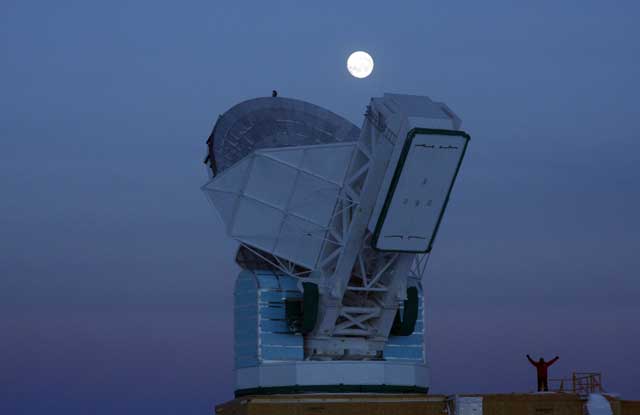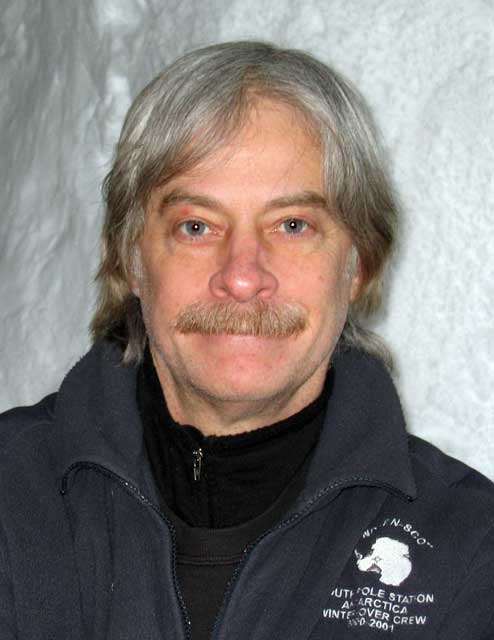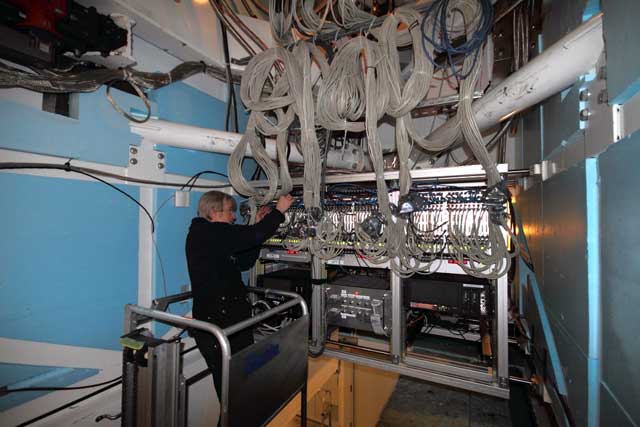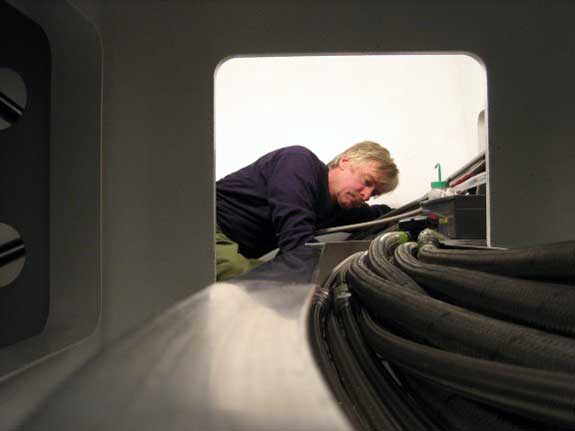|
Going the distanceOne South Pole scientist puts in the miles for astrophysical researchPosted September 20, 2013
Dana Hrubes estimates he has walked more than 5,000 miles across Antarctica. He is not a polar explorer, though he has certainly had his share of adventures in the polar regions. Nor did he accomplish the feat in one long, harrowing journey. Hrubes has literally walked the distance mile by mile, day after day, during seven winters at the South Pole as part of his job as a scientist in support of research into some of the biggest mysteries of the universe. That’s seven years of temperatures capable of reaching below minus 100 degrees Fahrenheit — so cold that fuel turns to jelly and frostbite attacks exposed skin within minutes. Seven years of blowing snow, poor visibility and record winds — including a storm raging at 50 knots in September 2011. “I never missed a day walking out in seven years,” says Hrubes during a phone interview from the Dark Sector Lab, about a mile from the main South Pole Station The Dark Sector, where no RF emissions are allowed, is home to some of the world’s cutting-edge experiments in astrophysics. That includes the South Pole Telescope The SPT, as it’s called, is a versatile instrument, making discoveries on scales both grand and small, from spying the formation of galaxies to measuring the mass of subatomic neutrinos. “I love the project. I’ve gotten more and more into cosmology, and the field of experimental cosmology has just exploded since the late ’90s, primarily because of the advances in the instrumentation,” Hrubes says. “I’m lucky to be part of this team.” Hrubes was one of a million kids who dreamt of becoming an astronaut while growing up during the heyday of the 1950s and ’60s Space Race between the United States and Soviet Union. He even recalls seeing the Echo IA balloon-shaped satellite as it circled the Earth in low orbit in 1960. The scientific revolution — and the spirit of innovation and technology that reigned in those years — inspired him to get an undergraduate degree in mechanical engineering in 1975, followed by a master’s degree in aeronautics and astronautics from the Massachusetts Institute of Technology (MIT) At MIT, he met astronaut Russell Louis “Rusty” Schweickart, who advised Hrubes to lead an adventurous and activity-filled life if he wanted into the astronaut corps. “I ran right out and started doing things like jumping out of airplanes and stuff like that,” Hrubes says. For the next 30 years, he applied to be an astronaut with NASA His first job out of the academic chute was at NASA’s Jet Propulsion Laboratory (JPL) Hrubes left NASA by the early 1980s to take a job with a major technology company called TRW Inc., where he worked on chemical rockets and high-energy chemical lasers. Some of the work involved former President Ronald Reagan’s Strategic Defense Initiative program (also known as Star Wars). It was while with TRW Inc. that Hrubes got his first opportunity to travel to the polar regions. The company had won a contract with the U.S. Navy Hrubes had already attempted to reach the South Pole even earlier, in the 1970s, petitioning a professor at Stanford The affinity for cold climes started at a young age: Hrubes remembers stubbornly staying outdoors in the winter snow as long as possible, despite entreaties from his mother to come inside for dinner. “I used to always love the snow. I loved the darkness,” Hrubes explains. “It’s a weird thing. My favorite time of the year was mid-December when it got dark at four o’clock in the afternoon. I always liked the cold.” Finally, in 2000-01, he got a big dose of cold and dark: Hrubes was hired in science support for the South Pole Station. He would return two more winters in 2004 and 2005 in a similar role before landing with the South Pole Telescope, a project based at the University of Chicago “I wanted to come down as a grantee,” says Hrubes, who is on sabbatical (once again) from his “day” job at the Naval Research Lab’s Naval Undersea Warfare Center Rockets. Lasers. Robots. Telescopes. Hrubes has certainly eschewed any scientific niche over his career. “I always liked to vary what I did,” he says. “I like to keep a hand in everything. It makes it interesting over the years.” The seven winters include three stints as the station science leader. Only three people have spent more time at the end of the world during its darkest and coldest months. And this year Hrubes will mark another milestone on the Ice: His 60th birthday is this month. “I don’t feel like it. I don’t feel like I’m 60. I don’t feel any different than I did in my 20s,” he says, half-jokingly, half-seriously crediting all those miles walked between his lab and the elevated station building. “It probably keeps you young to stay fit.” He certainly hasn’t lost the child-like wonder of the stars and heavens on those daily walks. “My greatest memories are of the night sky and the auroras. It’s almost as if the place were like magic,” Hrubes says. “You might as well be on Mars. You’re on the bottom of the Earth. There’s nobody around you, and the station is a mile away. It’s a neat feeling.” Follow Hrubes' polar adventures on his website. |



For USAP Participants |
For The Public |
For Researchers and EducatorsContact UsU.S. National Science FoundationOffice of Polar Programs Geosciences Directorate 2415 Eisenhower Avenue, Suite W7100 Alexandria, VA 22314 Sign up for the NSF Office of Polar Programs newsletter and events. Feedback Form |







